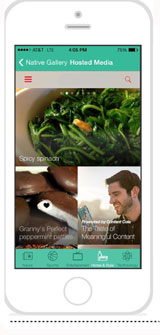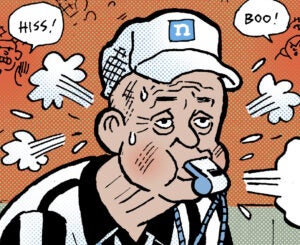 The native ad company Sharethrough expanded its services nearly three years ago from a purely video ad platform to multiple types of branded content.
The native ad company Sharethrough expanded its services nearly three years ago from a purely video ad platform to multiple types of branded content.
The move to include additional branded content has paid off. The company raised $17 million in a third round of funding in January. It also released a new SDK in early April for delivering native ads across desktop, mobile Web and apps.
AdExchanger spoke with CEO Dan Greenberg about the company’s transformation.
AdExchanger: In 2010, you described Sharethrough as a social video advertising company and now it’s an in-feed ad exchange. When did the transition happen?
DAN GREENBERG: Our mission has always been the same: to move the ad paradigm from obnoxious ads to quality content. In our early days, that took the form of video. We were distributing video content, ultimately natively, through the Web and not through banners, preroll, search or other interruptions, but in a way that’s integrated into the sites.
We expanded beyond video about two and a half years ago when we built a product that opens up our platform to distribute nonvideo content. We introduced sponsored stories, where brands can promote stories like BuzzFeed articles or content from their blog.
About a year and a half ago, we launched the exchange. We took everything we were doing through the ad server and made it so that it’s now a biddable, programmatic exchange.
Do you serve both publishers and advertisers?
On one side, we have brands that are distributing content like video, editorial and photos. One the other side, there are about 300 sites that are using Sharethrough, publishers who are monetizing their feeds with that branded content, which is made native to everything else you see in the feed.
What about more traditional online ads?
The angle we take is still true to our core in that we believe feeds should be monetized with content that users actually derive value from. At the same time, users should not feel tricked. They should know it’s sponsored content. Our core has always been about content.
We monetize feeds with content, not banner and direct-response and traditional ads. The brands that use Sharethrough come to us after they’ve created some content, video or editorial. And they use Sharethrough to distribute that content into other publishers around the Web.
The term “programmatic native ad exchange” is becoming a buzzword. How do you differentiate your solution?
In two ways. Sharethrough’s in-feed exchange is bigger than anything else in the market. We see nearly 1 billion in-feed native impressions a month. And we’re working with large publishers like Time Inc. and Forbes, which are using Sharethrough to monetize their feeds on the mobile Web and the desktop and now, with our SDK, on apps.
Number two is we built this exchange for content. We’re betting that the future of mobile monetization and the future of feed monetization will be about content delivered natively into those feeds. When I say content, I mean posts and articles and videos that a reader would actually click on, that are promoted by brands, instead of just an ad.
How does Sharethrough’s native ad exchange differ from Facebook’s approach to programmatic native?
Whereas Facebook’s exchange (FBX) is built for in-feed, native ads just on Facebook, Sharethrough’s Exchange (STX) is built to scale native ads in the feeds of content publishers across the rest of the Web.
Through a proprietary ad-serving technology that Sharethrough calls “Real-time Templating,” STX is able to programmatically adapt every ad to the form and function of each publisher feed, essentially “templating” the ad at the moment of the impression.
To maintain quality and long-term user engagement, both Facebook and Sharethrough have introduced core technology that biases their ad auctions. In a similar model to Facebook’s news feed algorithm (formerly EdgeRank), Sharethrough’s utilizes its Content Quality Score as a signal that biases the auction, rewarding higher-quality content in the exchange.
What determines a high Content Quality Score?
Some of the factors considered in the quality score are social sharing data, view and time data, sentiment analysis on related topics and content type-specific sources (e.g. YouTube specific metrics).
What is the process for turning content into a native ad and in what ways can you target the ads?
Advertisers log in and upload their content, like a list of Tumblr posts or Vine videos. A brand will log in and see that they can target categories like finance, tech and sports and within each of those categories there are native publisher sites. These are sites like People.com, TMZ, Warner Brothers, Politico, Real Simple – publishers that are meaningful publishers, but don’t have the same scale as Facebook or Twitter.
People.com, for example, is not big enough to justify their own closed platform ad-management system, so they’re using Sharethrough to monetize their feeds with brand content. The brand puts in targets, budgets, bids similar to Facebook and Twitter, and it goes live in real time.
They get data back on impressions and clicks and performance and views and expansions and ad core metrics. They can automatically optimize for the highest engagement rates across their entire content library.
The standard campaign might run across 300 different sites and on every site it runs on, it’s native to that site in real time on the impression level.
How do you convert different types of creative into a native ad that matches the different publishers’ sites?
When advertisers upload their content onto Sharethrough, our system disassembles the content into components and reassembles those parts into the native template of the site in real time per impression.
Those component parts are things like the headline, the description, the thumbnail, the brand name and the tracking pixels. So instead of serving banner ads, we’re serving metadata and the metadata assembles itself on the site’s template in real time.
All the native ad companies are doing something similar to this through their own approach. But it’s being standardized right now and there will probably be a standard for an extension to Open RTB (the buying protocol for real-time bidding) specifically for in-feed native ads.
Is there a conflict in the idea of standardizing native ads?
Native doesn’t have to mean custom-made. What native means to me are ads that match the form and function of the sites they live on. There are ways of creating custom codes and publishers doing it themselves, but we’re doing it programmatically.
For form, our technology analyzes the page to identify the atomic unit of the page and automatically renders the ad to match the form of the site. Function means if the function of the website is to have users reading stories or watching videos, then an ad also needs to be a story or a video.
But if you’re inserting a teeth whitening ad into the visual design of the feed, it’s not really native unless it matches the function of the site.
What performance metrics are you using?
CPMs and CPEs, which are blanket terms for things like cost per click and cost per view. Facebook and Twitter have started doing cost per installs but I think CPM is a really good starting point.
And when we’re talking about CPM, I’m also talking about 100% viewable impressions. In the debate about viewability, we’re taking the stance that an impression is not an impression until it’s a viewable impression that meets the official metric (50% of the ad is in view on the user’s screen for at least one second).
In terms of our inventory, it’s about 60% video and 40% editorial content. So 60% of the ads are filled with videos in the feed. And we don’t do any preroll videos.
What trends are you watching?
Two huge trends are happening right now. One is publishers are moving to a mobile-first, feed-based Web design and then using the mobile sites to inform their desktop design. In a couple years, everyone is going to have a mobile optimized site, but you’re going to see desktop sites that are also cleaner and have a singular feed as opposed to banners and boxes on every page. For computers, smartphones and tablets, the battle for modernization will be won or lost on the feed.
Two is brands are creating more actual content. And as brands are producing more content, we’re building features that allow brands to distribute all kinds of content through Sharethrough. One of the things we’re doing is building a content library system so brands can discover content and promote it through the whole platform. We’re betting on content and the best long-term way to monetize feeds is with branded content.













